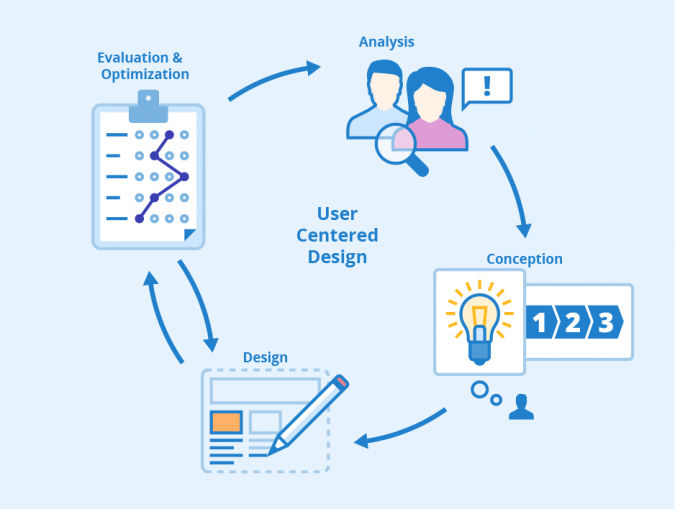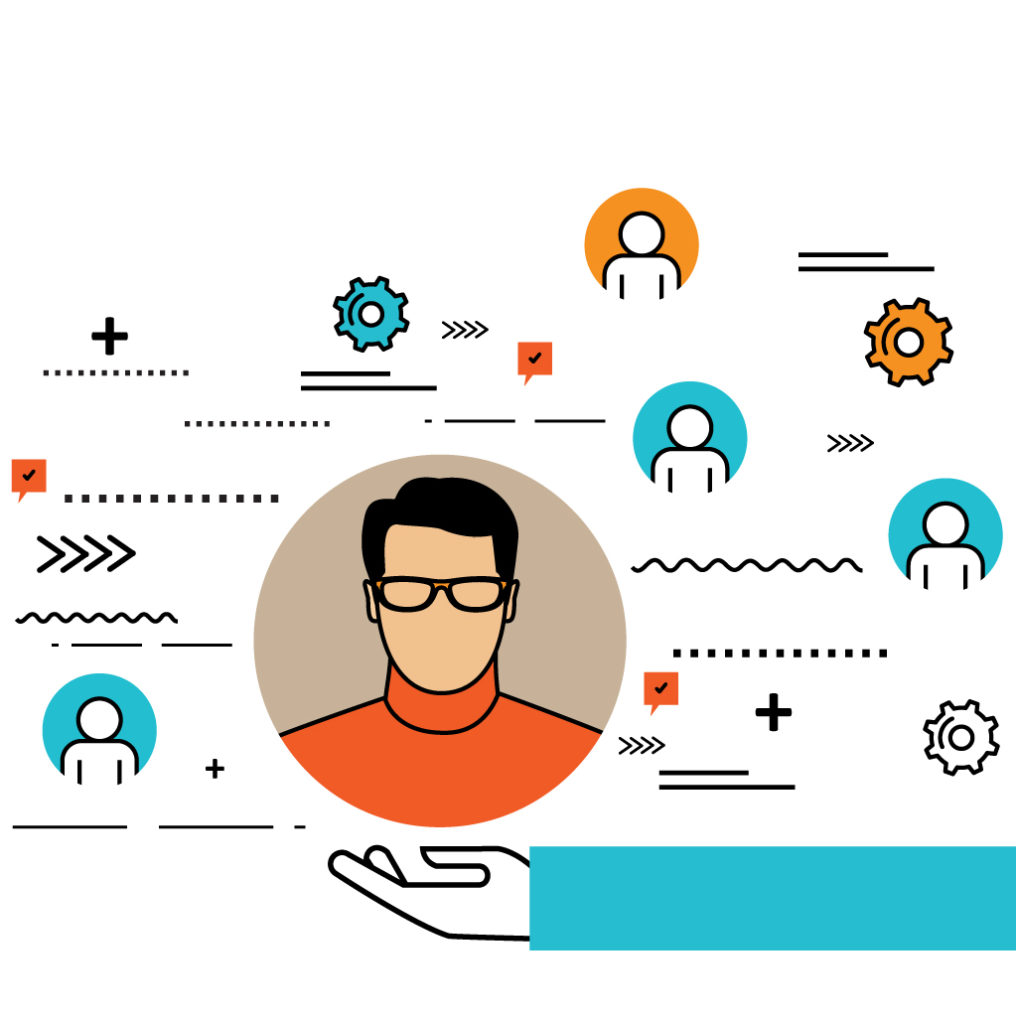| English | Polish |
|---|---|
User-centered design encompasses different research and design tactics that involve the user in each stage of the design process. By keeping the users so actively involved in the process, they’ll stay at the forefront of your design decisions—helping you tailor your design specifically to their needs. | Projektowanie zorientowane na użytkownika obejmuje różne badania i taktyki projektowe, które angażują użytkownika na każdym etapie procesu projektowania. Utrzymywanie użytkowników aktywnie zaangażowanych w ten proces sprawi, że będziesz miał ich stale na uwadze podczas podejmowania decyzji projektowych, co pomoże ci odpowiednio dostosować projekt do ich potrzeb. |
What is user-centered design?
| English | Polish |
|---|---|
User-centered design is an iterative design process framework that incorporates validation from the user every step of the way. This closeness and frequent interaction helps you deeply understand your user, what they want and don’t want from your design, and how they’re going to interact with each part of your product. | Projektowanie zorientowane na użytkownika to iteracyjny schemat procesu projektowania, w którym użytkownik weryfikuje każdy jego etap. Ta bliskość i częste interakcje pomagają dogłębnie zrozumieć użytkownika, czego oczekuje od projektu, a czego sobie nie życzy, i jak będzie wchodził w interakcję z każdym elementem produktu. |
The user-centered design process typically takes four steps: Step 1. Identify the users’ needs and the context around them. Step 2. Specify requirements for both the business and user. Step 3. Design solutions. Step 4. Evaluate. | Proces projektowania zorientowany na użytkownika obejmuje zazwyczaj cztery kroki: Krok 1. Określenie potrzeb użytkowników i kontekstu. Krok 2. Określenie wymagań zarówno dla firmy, jak i dla użytkownika. Etap 3. Projektowanie rozwiązań. Krok 4. Ocena. |
This is based on the process determined by the International Organization of Standardization (ISO), an organization dedicated to bringing professionals and experts together to set industrial, scientific, and business standards. | Opiera się to na procesie określonym przez Międzynarodową Organizację Normalizacyjną (ISO), która skupia specjalistów i ekspertów w celu ustalenia norm przemysłowych, naukowych i biznesowych. |

The process of user-centered design
| English | Polish |
|---|---|
Step 1. Identify the users’ needs and context around them The first step is the start of your user research: when you find out everything you need to know about your user in order to craft a product that satisfies their needs. To do this, you need to answer three questions: | Krok 1. Określenie potrzeb użytkowników i kontekstu Pierwszym krokiem jest rozpoczęcie badań użytkowników, podczas którego dowiesz się wszystkiego, co musisz wiedzieć o swoim użytkowniku, aby stworzyć produkt, który zaspokoi jego potrzeby. Aby to zrobić, musisz odpowiedzieć na trzy pytania: |
Who is my user? You need to find out the type of people who will be using your product and, more importantly, what their goals are. What are my users’ problems? These are the issues facing your users that your product, and design, and directly and indirectly help solve. What are they about? This can mean everything from how they’re going to be interacting with your design to even the emotions they feel while using it. | Kto jest moim użytkownikiem? Musisz dowiedzieć się, kto będzie korzystał z twojego produktu i, co ważniejsze, jakie są jego cele. Jakie są problemy moich użytkowników? Są to problemy, z którymi borykają się twoi użytkownicy, a które twój produkt i projekt pomogą bezpośrednio i pośrednio rozwiązać. Co zamierzają? Może to oznaczać wszystko, począwszy od tego, jak będą wchodzić w interakcję z projektem, aż po emocje, które odczuwają podczas jego użytkowania. |
Step 2. Specify requirements for both business and user Now that you know your users and their needs, it’s time to understand your metrics of success. This means having a clear idea of two things: | Krok 2. Określenie wymagań zarówno dla firmy, jak i użytkownika Teraz gdy znasz swoich użytkowników i ich potrzeby nadszedł czas, aby zrozumieć swoje wskaźniki sukcesu. Oznacza to posiadanie jasnego wyobrażenia o dwóch rzeczach: |
Business requirements. These are the goals and outcomes that you as the designer and business owner are hoping to achieve. This can include expected revenue, key stakeholders, and the scope of the design. | Wymaganiach biznesowych. Są to cele i rezultaty, które ty jako projektant i właściciel firmy macie nadzieję osiągnąć. Mogą one obejmować oczekiwane przychody, kluczowych interesariuszy oraz zakres projektu. |
User requirements. This is everything the user stands to gain from the process and can include the problems design is solving, and the results of successful design. | Wymaganiach użytkownika. Korzyści, jakie użytkownik będzie mógł uzyskać, m.in. rozwiązanie problemów oraz wyniki udanego projektu. |
These both address the big why: why is this design beneficial for both the business and the user? Why is it worth your time to do it right now? | Obie te grupy wymagań dotyczą ważnych pytań: dlaczego ten projekt jest korzystny zarówno dla firmy, jak i dla użytkownika? Dlaczego teraz warto poświęcić na to swój czas? |
Step 3. Design solutions Now that you’ve identified your users’ needs as well as your metrics for success, it’s time to actually set out and design solutions for them. | Krok 3. Projektowanie rozwiązań Teraz, gdy już zidentyfikowałeś potrzeby swoich użytkowników, jak również twoje wskaźniki sukcesu, nadszedł czas, aby określić i zaprojektować rozwiązania. |
This is the stage of the process that any designer should be familiar with. It means building and deciding on assets like: – Site map – Wireframes – Prototypes – Mock-ups – Images – Icons – Colors Once you’ve actually designed out your assets to address your target users’ issues, it’s time to move onto the final step. | Jest to etap procesu, z którym każdy projektant powinien być zaznajomiony. Oznacza tworzenie i podejmowanie decyzji dotyczących takich elementów jak: – Mapa witryny – Szkielety – Prototypy – Makiety – Obrazy – Ikony – Kolory Skoro już zaprojektowałeś elementy, które mają rozwiązać problemy docelowych użytkowników, nadszedł czas, aby przejść do ostatniego kroku. |
Step 4. Evaluate Now it’s time to analyze and evaluate your designs against the user and business requirements. This is going to be an overall look at your final product to see if it meets all of the goals you set out for yourself in step two. | Krok 4. Ocena Teraz nadszedł czas, aby przeanalizować i ocenić projekty pod kątem wymagań użytkownika i biznesu. Będzie to ogólne spojrzenie na końcowy produkt, aby sprawdzić, czy realizuje on wszystkie cele, które wyznaczyłeś w drugim kroku. |
Some questions you might ask: – Where did our process go right? Why? – Where did we struggle? Why? – How are our users responding to the product? – Did it solve their issues and pain points? – Where can we improve the product? – What lessons can we take away from this process for future products? | Kilka pytań, które możesz zadać: – Gdzie proces przebiegał prawidłowo? Dlaczego? – Gdzie mieliśmy problemy? Dlaczego? – Jak nasi użytkownicy reagują na produkt? – Czy to rozwiązało ich problemy? – Gdzie możemy ulepszyć produkt? – Jakie wnioski możemy wyciągnąć z tego procesu dla przyszłych produktów? |
If you find that you didn’t meet the goals and requirements that you’ve set for your product, that’s okay! It’s to be expected and is all part of the process that will eventually lead you to success. | Jeśli okaże się, że nie zrealizowałeś celów i wymagań, które postawiłeś przed swoim produktem, to nic się nie stało! Należy się tego spodziewać i to wszystko jest częścią procesu, który w końcu doprowadzi cię do sukcesu. |
Step 5. Iteration While not technically a step, it’s what comes after you’ve run through the four-step user-centered design process. What that means now is iterating. That means going back to step one and starting the user-centered design process over — but with the knowledge you gained in the first round. | Krok 5. Iteracja Choć technicznie nie jest to krok, jest to działanie, które następuje po przejściu przez czteroetapowy proces projektowania zorientowanego na użytkownika. Tym działaniem jest iteracja. Oznacza ona powrót do kroku pierwszego i rozpoczęcie procesu projektowania zorientowanego na użytkownika od nowa – ale z wiedzą zdobytą podczas pierwszego przebiegu procesu. |
You’ll be able to tighten all the screws that need to be tightened and make the changes that need to be made — though this may not happen in the second round of changes either. You might have to go back for several rounds before it all gets done, and that’s okay too! What’s important is that you come up with a product that will meet your users’ needs and your goals. Eventually, it’ll come time to launch—and even then, you might spend some more time tweaking and fixing some aspect of your product. | Będziesz mógł dopracować projekt i dokonać niezbędnych zmian – choć może to nie nastąpić nawet w drugim cyklu zmian. Być może będziesz musiał przejść przez proces kilka razy, zanim wszystko zostanie zrobione, ale to też jest w porządku! Ważne jest, abyś wymyślił produkt, który będzie odpowiadał potrzebom użytkowników i twoim celom. W końcu nadejdzie czas na wprowadzenie produktu na rynek i nawet wtedy możesz poświęcić trochę więcej czasu na udoskonalanie i naprawianie niektórych elementów twojego produktu. |
Source of English text: https://www.invisionapp.com/inside-design/user-centered-design-definition-examples-and-tips/
Exercises
Exercise 1.
Answer the questions
- What is user-centered design?
- Why is user-centered design useful?
- What are the four steps of the user-centered design process?
- What is user-research about?
- What are two types of requirements?
- What is the big why?
- What assets does the designer build?
- How do you evaluate your designs?
- What is meant by 'iteration’?
- What is the ultimate goal of the whole process of user-centered design?
